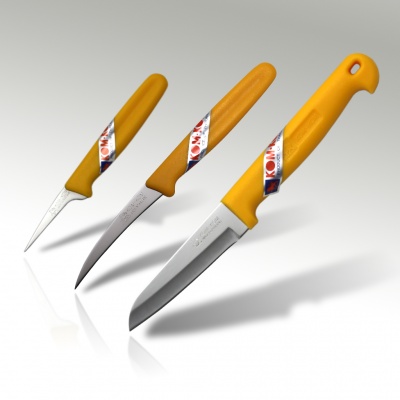001B - Kom-Kom three inch seeding knife with a high carbon stainless steel blade and a yellow plastic handle.
A seeding knife has a pointed tip that curves downwards towards the blade cutting edge. This style of knife is also often referred to as a birds beak or "tournée" knife. In Thailand they are often used for removing seeds from fresh exotic fruits such as rambutan, zalacca, longan, lychee etc. They are also used along with other specialist carving knives to create intricate fruit carvings. They are also used for other purposes that require some skilled or detailed work like removing chicken giblets etc. See the illustrations above for some examples of how to use it as a seeding knife.
The razor sharp cutting edge has a chisel grind, which means that it is bevelled on one side only. This results in a super sharp cutting edge which is perfect when being used for creating detailed fruit carvings.

The blade is made from Japanese high carbon Martensitic stainless steel (SUS420J2) which has been hardened and tempered for optimal sharpness. The razor sharp cutting edge has an asymmetrical grind which is perfect for fruit carving. The yellow plastic handle is made from a durable and hygienic polypropylene.
This knife can also be purchased as part of a set of 3 knives in the Kom-Kom (C) knife set.
Keep the blade away from strong acids or alkalis such as fish sauce or vinegar.
Do not use wire wool to clean as it may damage the blade. Wash with a soft sponge and dry immediately.
Avoid putting wooden handled knives in a dishwasher as the high temperature and extended period in water will shrink and dry the wood and will ultimately ruin the knife.
This knife is made with a Japanese high carbon martensitic stainless steel alloy(SUS420J2) which has the benefit of being harder and therefore sharper than many other stainless steels but the trade-off is that they are more prone to staining.
If your knife has a wooden handle, it is recommended to oil the handle occasionally with a food grade oil. The choice of oil is a personal preference however groundnut and rapeseed oil appear to be popular but avoid olive oil as this can go rancid quite quickly. This will help maintain the wood and keep your knife looking like new. Be very careful while doing this to avoid cutting yourself.
Store knives in a dedicated storage solution such as a wooden box or wall hanger, see our knife storage options .
Keep in a safe location away from children.


.jpg)
.jpg)
.jpg)

.jpg)


.jpg)


.jpg)
.jpg)
.jpg)
.jpg)
.jpg)

.jpg)
.jpg)
.jpg)
.jpg)